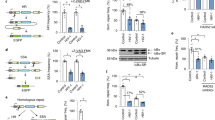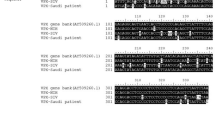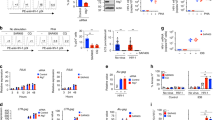Abstract
APOBEC3G (A3G) is an intrinsic antiviral factor that inhibits the replication of human immunodeficiency virus (HIV) by deaminating cytidine residues to uridine. This causes guanosine-to-adenosine hypermutation in the opposite strand and results in inactivation of the virus. HIV counteracts A3G through the activity of viral infectivity factor (Vif), which promotes degradation of A3G. We report that viral protein R (Vpr), which interacts with a uracil glycosylase, also counteracted A3G by diminishing the incorporation of uridine. However, this process resulted in activation of the DNA-damage–response pathway and the expression of natural killer (NK) cell–activating ligands. Our results show that pathogen-induced deamination of cytidine and the DNA-damage response to virus-mediated repair of the incorporation of uridine enhance the recognition of HIV-infected cells by NK cells.
This is a preview of subscription content, access via your institution
Access options
Subscribe to this journal
Receive 12 print issues and online access
$209.00 per year
only $17.42 per issue
Buy this article
- Purchase on Springer Link
- Instant access to full article PDF
Prices may be subject to local taxes which are calculated during checkout







Similar content being viewed by others
References
Deeks, S.G. & Walker, B.D. Human immunodeficiency virus controllers: mechanisms of durable virus control in the absence of antiretroviral therapy. Immunity 27, 406–416 (2007).
Peng, G., Lei, K.J., Jin, W., Greenwell-Wild, T. & Wahl, S.M. Induction of APOBEC3 family proteins, a defensive maneuver underlying interferon-induced anti-HIV-1 activity. J. Exp. Med. 203, 41–46 (2006).
Chiu, Y.-L. & Greene, W.C. The APOBEC3 cytidine deaminases: an innate defensive network opposing exogenous retroviruses and endogenous retroelements. Annu. Rev. Immunol. 26, 317–353 (2008).
Zhang, H. et al. The cytidine deaminase CEM15 induces hypermutation in newly synthesized HIV-1 DNA. Nature 424, 94–98 (2003).
Bishop, K.N., Verma, M., Kim, E.-Y., Wolinsky, S.M. & Malim, M.H. APOBEC3G inhibits elongation of HIV-1 reverse transcripts. PLoS Pathog. 4, e1000231 (2008).
An, P. et al. APOBEC3G genetic variants and their influence on the progression to AIDS. J. Virol. 78, 11070–11076 (2004).
Yu, X. et al. Induction of APOBEC3G ubiquitination and degradation by an HIV-1 Vif-Cul5-SCF complex. Science 302, 1056–1060 (2003).
Kijak, G.H. et al. Variable contexts and levels of hypermutation in HIV-1 proviral genomes recovered from primary peripheral blood mononuclear cells. Virology 376, 101–111 (2008).
Jern, P., Russell, R., Pathak, V. & Coffin, J. Likely role of APOBEC3G-mediated G-to-A mutations in HIV-1 evolution and drug resistance. PLoS Pathog. 5, e1000367 (2009).
Goulder, P.J.R. & Watkins, D.I. Impact of MHC class I diversity on immune control of immunodeficiency virus replication. Nat. Rev. Immunol. 8, 619–630 (2008).
Schwartz, O., Maréchal, V., Le Gall, S., Lemonnier, F. & Heard, J.M. Endocytosis of major histocompatibility complex class I molecules is induced by the HIV-1 Nef protein. Nat. Med. 2, 338–342 (1996).
Collins, K.L., Chen, B.K., Kalams, S.A., Walker, B.D. & Baltimore, D. HIV-1 Nef protein protects infected primary cells against killing by cytotoxic T lymphocytes. Nature 391, 397–401 (1998).
Martin, M.P. et al. Innate partnership of HLA-B and KIR3DL1 subtypes against HIV-1. Nat. Genet. 39, 733–740 (2007).
Le Gall, S. et al. Nef interacts with the mu subunit of clathrin adaptor complexes and reveals a cryptic sorting signal in MHC I molecules. Immunity 8, 483–495 (1998).
Jennes, W. et al. Cutting edge: resistance to HIV-1 infection among African female sex workers is associated with inhibitory KIR in the absence of their HLA ligands. J. Immunol. 177, 6588–6592 (2006).
Martin, M.P. et al. Epistatic interaction between KIR3DS1 and HLA-B delays the progression to AIDS. Nat. Genet. 31, 429–434 (2002).
Morvan, M. et al. Phenotypic and functional analyses of KIR3DL1+ and KIR3DS1+ NK cell subsets demonstrate differential regulation by Bw4 molecules and induced KIR3DS1 expression on stimulated NK cells. J. Immunol. 182, 6727–6735 (2009).
Champsaur, M. & Lanier, L. Effect of NKG2D ligand expression on host immune responses. Immunol. Rev. 235, 267–285 (2010).
Fogli, M. et al. Lysis of endogenously infected CD4+ T cell blasts by rIL-2 activated autologous natural killer cells from HIV-infected viremic individuals. PLoS Pathog. 4, e1000101 (2008).
Ward, J. et al. HIV-1 Vpr triggers natural killer cell-mediated lysis of infected cells through activation of the ATR-mediated DNA damage response. PLoS Pathog. 5, e1000613 (2009).
Schröfelbauer, B., Yu, Q., Zeitlin, S.G. & Landau, N.R. Human immunodeficiency virus type 1 Vpr induces the degradation of the UNG and SMUG uracil-DNA glycosylases. J. Virol. 79, 10978–10987 (2005).
Mansky, L.M., Preveral, S., Selig, L., Benarous, R. & Benichou, S. The interaction of vpr with uracil DNA glycosylase modulates the human immunodeficiency virus type 1 In vivo mutation rate. J. Virol. 74, 7039–7047 (2000).
Cerboni, C. et al. Human immunodeficiency virus 1 Nef protein downmodulates the ligands of the activating receptor NKG2D and inhibits natural killer cell-mediated cytotoxicity. J. Gen. Virol. 88, 242–250 (2007).
Russell, R.A. & Pathak, V.K. Identification of two distinct human immunodeficiency virus type 1 Vif determinants critical for interactions with human APOBEC3G and APOBEC3F. J. Virol. 81, 8201–8210 (2007).
Gasser, S., Orsulic, S., Brown, E. & Raulet, D. The DNA damage pathway regulates innate immune system ligands of the NKG2D receptor. Nature 436, 1186–1190 (2005).
Branzei, D. & Foiani, M. Regulation of DNA repair throughout the cell cycle. Nat. Rev. Mol. Cell Biol. 9, 297–308 (2008).
Hickson, I. et al. Identification and characterization of a novel and specific inhibitor of the ataxia-telangiectasia mutated kinase ATM. Cancer Res. 64, 9152–9159 (2004).
Mansky, L.M., Preveral, S., Selig, L., Benarous, R. & Benichou, S. The interaction of vpr with uracil DNA glycosylase modulates the human immunodeficiency virus type 1 in vivo mutation rate. J. Virol. 74, 7039–7047 (2000).
Casartelli, N. et al. The antiviral factor APOBEC3G improves CTL recognition of cultured HIV-infected T cells. J. Exp. Med. 207, 39–49 (2009).
Gourzi, P., Leonova, T. & Papavasiliou, F.N. A role for activation-induced cytidine deaminase in the host response against a transforming retrovirus. Immunity 24, 779–786 (2006).
Maasho, K., Opoku-Anane, J., Marusina, A.I., Coligan, J.E. & Borrego, F. NKG2D is a costimulatory receptor for human naive CD8+ T cells. J. Immunol. 174, 4480–4484 (2005).
Schrader, C.E., Linehan, E.K., Mochegova, S.N., Woodland, R.T. & Stavnezer, J. Inducible DNA breaks in Ig S regions are dependent on AID and UNG. J. Exp. Med. 202, 561–568 (2005).
Stenglein, M.D., Burns, M.B., Li, M., Lengyel, J. & Harris, R.S. APOBEC3 proteins mediate the clearance of foreign DNA from human cells. Nat. Struct. Mol. Biol. 17, 222–229 (2010).
Altan-Bonnet, G. & Libchaber, A. Bubble dynamics in double-stranded DNA. Phys. Rev. Lett. 90, 138101 (2003).
Sire, J., Quérat, G., Esnault, C. & Priet, S. Uracil within DNA: an actor of antiviral immunity. Retrovirology 5, 45 (2008).
Priet, S. et al. HIV-1-associated uracil DNA glycosylase activity controls dUTP misincorporation in viral DNA and is essential to the HIV-1 life cycle. Mol. Cell 17, 479–490 (2005).
Yang, B., Chen, K., Zhang, C., Huang, S. & Zhang, H. Virion-associated uracil DNA glycosylase-2 and apurinic/apyrimidinic endonuclease are involved in the degradation of APOBEC3G-edited nascent HIV-1 DNA. J. Biol. Chem. 282, 11667–11675 (2007).
Pauli, E.-K. et al. High level expression of the anti-retroviral protein APOBEC3G is induced by influenza A virus but does not confer antiviral activity. Retrovirology 6, 38 (2009).
Heil, F. et al. Species-specific recognition of single-stranded RNA via toll-like receptor 7 and 8. Science 303, 1526–1529 (2004).
Collins, K.L. & Baltimore, D. HIV's evasion of the cellular immune response. Immunol. Rev. 168, 65–74 (1999).
Lahm, H.W. & Stein, S. Characterization of recombinant human interleukin-2 with micromethods. J. Chromatogr. A 326, 357–361 (1985).
Schaefer, M.R., Wonderlich, E.R., Roeth, J.F., Leonard, J.A. & Collins, K.L. HIV-1 Nef targets MHC-I and CD4 for degradation via a final common beta-COP-dependent pathway in T cells. PLoS Pathog. 4, e1000131 (2008).
Qin, X.-F., An, D.S., Chen, I.S.Y. & Baltimore, D. Inhibiting HIV-1 infection in human T cells by lentiviral-mediated delivery of small interfering RNA against CCR5. Proc. Natl. Acad. Sci. USA 100, 183–188 (2003).
Galbán, S. et al. Cytoprotective effects of IAPs revealed by a small molecule antagonist. Biochem. J. 417, 765–771 (2009).
Zhang, H. et al. Novel single-cell-level phenotypic assay for residual drug susceptibility and reduced replication capacity of drug-resistant human immunodeficiency virus type 1. J. Virol. 78, 1718–1729 (2004).
Carter, C.C. et al. HIV-1 infects multipotent progenitor cells causing cell death and establishing latent cellular reservoirs. Nat. Med. 16, 446–451 (2010).
Nakai-Murakami, C. et al. HIV-1 Vpr induces ATM-dependent cellular signal with enhanced homologous recombination. Oncogene 26, 477–486 (2007).
Yamamoto, N. et al. Analysis of human immunodeficiency virus type 1 integration by using a specific, sensitive and quantitative assay based on real-time polymerase chain reaction. Virus Genes 32, 105–113 (2006).
Acknowledgements
We thank the AIDS Research and Reference Reagent Program, Division of AIDS, National Institute of Allergy and Infectious Diseases, US National Institutes of Health; M. Gately (Hoffmann La Roche) for human recombinant interleukin 2; H. Zhang, Y. Zhou and R. Siliciano (Johns Hopkins University) for pNL4-3-ΔE-EGFP (11100); K. Strebel (National Institute of Allergy and Infectious Diseases, US National Institutes of Health) for A3G antiserum (ApoC17); M.H. Malim (King's College London) for monoclonal antibody 319 to HIV-1 Vif; BioMolecular Technologies for antiserum to HIV-1SF2 p24; and the University of Michigan Flow Cytometry core, Sequencing Core (US National Institutes of Health grant P30CAO46592) and Hybridoma Core (US National Institutes of Health grant P30AR048310) and the Center for Statistical Consultation for services. Supported by US National Institutes of Health (R01 AI051192; T32GM007863 and T32AI007413 to M.M.; and UL1RR024986 (National Center for Research Resources) to A.O.-N.), US National Science Foundation (DGE 0718128 to L.A.M.). The content is solely the responsibility of the authors and does not necessarily represent the official views of National Center for Research Resources or the US National Institutes of Health.
Author information
Authors and Affiliations
Contributions
J.M.N. and K.L.C. designed the experiments and prepared the manuscript; J.M.N., M.M., L.A.M., A.O.-N., W.S. and E.C.-F. did experiments; and all authors read and edited the manuscript.
Corresponding author
Ethics declarations
Competing interests
The authors declare no competing financial interests.
Supplementary information
Supplementary Text and Figures
Supplementary Figures 1–2 and Tables 1–3 (PDF 526 kb)
Rights and permissions
About this article
Cite this article
Norman, J., Mashiba, M., McNamara, L. et al. The antiviral factor APOBEC3G enhances the recognition of HIV-infected primary T cells by natural killer cells. Nat Immunol 12, 975–983 (2011). https://doi.org/10.1038/ni.2087
Received:
Accepted:
Published:
Issue Date:
DOI: https://doi.org/10.1038/ni.2087
This article is cited by
-
Natural killer cells in antiviral immunity
Nature Reviews Immunology (2022)
-
Keratinocyte differentiation induces APOBEC3A, 3B, and mitochondrial DNA hypermutation
Scientific Reports (2018)
-
Insufficient natural killer cell responses against retroviruses: how to improve NK cell killing of retrovirus-infected cells
Retrovirology (2016)
-
NK Cells in HIV Disease
Current HIV/AIDS Reports (2016)
-
Innate immunity against HIV-1 infection
Nature Immunology (2015)



